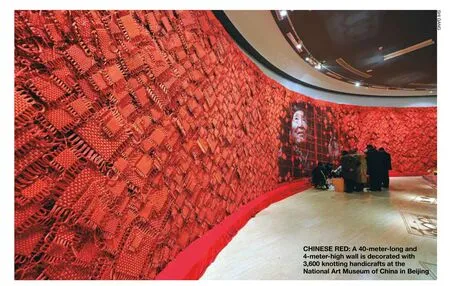More Than Just Handicrafts
2011-10-14ByCHENRAN
By CHEN RAN
More Than Just Handicrafts
By CHEN RAN
An art exhibition draws attention to rural cultural industry

Against the backdrop of a huge painting of willow trees at the National Art Museum of China in downtown Beijing, Wang Fujing, 40, wove willow twigs into a flower basket as if he were at home. The only difference was he had to stop to explain his weaving technique when visitors asked questions.
Wang was among 11 handicraftsmen showcasing the creativity and ingenuity of Chinese farmers at an art exhibition named Handicrafts in the Countryside.
The exhibition, held on January 9-18, was the culmination of a research project on handicrafts made by farmers in east China’s Shandong Province. Works displayed included kites, paintings, carvings, weavings and knotting handicrafts. In addition to the items on display, the exhibition also featured cartoons, introductory videos, research notes and papers as well as opportunities for visitors to create crafts of their own.
Lifelong career
Wang, a farmer from Quanhezi Village, Linyi City, learned how to weave willow twigs when he was 16 years old. Since then, all his spare time has been devoted to weaving. Wang said, “[Making] handicrafts is a lifelong career.”
Wang said his favorite thing about weaving is that he can use his skills to make money at home, allowing him to spend more time with his family. Over the past decade, his monthly income from weaving has increased from 500 yuan ($62.50) to 2,000 yuan ($285). Wang is now free to sell his product to the highest bidder.
“I feel honored to be here because I never thought I could come to the capital to show off my handicrafts,” Wang said. “I was proud that the exterior of the Spain Pavilion at the 2010 Shanghai World Expo was made from wicker woven in our province. It was a showcase of our handicrafts. We have a saying: ‘There is no better job anywhere than sitting at home weaving willow twigs.’ I think this is true.”
Willow weaving has a long tradition in Wang’s hometown, which is rich in willow trees. Woven handicrafts have become a pillar industry for the local economy since the 1980s and many daily items such as baskets and food containers are woven from local willows.
Currently, Linyi has 802 companies in the woven handicraft industry, with 250,000 farmers producing woven goods. Products range from furniture, decorative pieces, to gardening and travel equipment. About 80 percent of production is sold overseas. In 2009 alone, the total value of crafts produced in Linyi was 6 billion yuan ($850 million).

1. CHINESE STYLE: A typical wooden gate in north China is displayed at the entrance of the Handicrafts in the Countryside exhibition2. WATCHING CAREFULLY: Visitors watch wood carvings3. HAVING FUN: A girl hangs a kite she made on the wall4. EASY JOB: Wang Fujing displays willow weaving techniques
Similar to Linyi’s woven products, all the handicrafts shown at the exhibition—kites and Spring Festival paintings from Yangjiabu Village; wood carvings from Caoxian County; cloth weaving from Zhencheng County; knottying handicrafts from Honghua Township; andgongbipaintings, a Chinese painting style featured with meticulous brush techniques, from Juye County—have brought about huge economic returns to local people.
New horizon
Begun in 2006, the handicrafts in the countryside project is partly the result of research conducted 30 years ago by Pan Lusheng, President of the Shandong University of Art and Design (SUAD).
Pan, who was born in 1962 in Caoxian County, has devoted much of his career to studying and protecting Chinese folk art. As part of his research, he visited more than 1,000 rural craftsmen, recorded 121 handicraft techniques, and collected over 30,000 handicrafts pieces. In 1989, he opened the country’s first folk arts museum. In 2004, he even proposed an academic discipline revolving around Chinese handicrafts.
The project, according to Pan, has profound economic and cultural significance for China, which has 900 million farmers, including 230 million migrant workers from rural areas.
“Our research opens a new horizon for rural handicrafts,” Pan said. “We can view rural areas from a cultural perspective, exploring new methods of developing culture in the countryside. We can take advantage of stay-athome handicraft-making as a feasible solution for problems related to the aging population and migrant workers in the rural area.”
Pan’s view was echoed by exhibition manager Zhao Yi, Dean of the School of Arts and Humanities at the SUAD. Zhao has been involved in Pan’s research project since 1997. Zhao said the event meant a great deal to the farmers involved.
“This is the frst time that rural handicrafts have been presented as a cultural project,”said Zhao. “We’d like to attract more attention from the whole country. The countryside today should not be labeled as ‘poor’ or ‘backward’anymore. It is a cradle of art.”
“On the one hand, this kind of work can help increase farmers’ income in their spare time without having to seek jobs elsewhere. On the other hand, it is not purely physical work, but also creative and artistic. It can help to make the countryside more modern and cultured,” Zhao said.
“Handicrafts are part of life,” Pan said.“They can make people in urban areas feel more connected to nature. I hope the exhibition and the project will encourage the protection of our intangible heritage, as well as help the craftsmen who make these works of art.”
Yang Xianrang, 81, a printmaker and senior researcher on Chinese folk art, was deeply impressed by the exhibition.
“From an artistic angle, every exhibit here is a great work of art,” he said.
“I saw a lot of art deco pieces when I was living in the United States. Looking around here, the pieces are fantastic!” Yang said.“From an economic angle, it is a great leap forward. It is a trend that will lead traditional rural handicrafts into a modern age.”
(For more photos and video clip, please visit Beijing Review website at http://www.bjreview.com/special/
2011-01/19/content_327181.htm)
